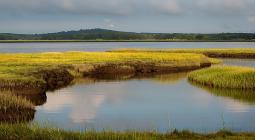Estuaries – the place where a river meets the ocean – are often called the “nurseries of the sea”. They are home to many of the fish we eat and support vast numbers of birds, while the surrounding salt marsh helps to stabilise shorelines and absorb floods.
However, a new study shows that nearly half of the world’s estuaries have been altered by humans, and 20% of this estuary loss has occurred in the past 35 years.
Using satellite data, researchers measured the changes that had occurred at 2,396 estuaries between 1984 and 2019. The results, published in the journal Earth’s Future, found that over the past 35 years more than 100,000 hectares (250,000 acres) of estuary have been converted into urban or agricultural land, with the majority of the loss (90%) having occurred in rapidly developing Asian countries.
By contrast, very little estuary loss has occurred in high-income countries during the past 35 years – mostly because extensive estuary alteration happened many decades before, during those countries’ own phase of rapid development.
Many high-income countries are now recognising and undoing the damage, with locations such as the Tees estuary in northern England investing in returning the area to mudflats and salt marsh to help reduce flood risk, increase resilience to the climate crisis, replenish fish populations, and let nature recover.






